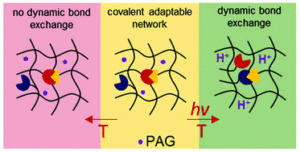Rossegger et al. employ a photolatent catalyst for the local activation of topological rearrangements in thermo-activated vitrimers.
Vitrimers are covalent adaptable polymers networks which have recently attracted tremendous interest thanks to their unique feature of switching from a classic thermoset behaviour to a malleable plastic upon heating. In particular, at low temperature, vitrimers exhibit properties similar to a thermoset (e.g. rigid, brittle, opaque, high strength, good chemical resistance, etc.). Instead, heating vitrimers to temperatures above their topological freezing temperature, leads to activation and exchange of the covalent bonds within the networks thereby allowing the polymer chains to flow like viscoelastic liquids. However, one of the main limitations of this thermoresponsive feature is the lack of spatial control. In their current contribution, Schlögl and coworkers report a novel photocatalyst that can introduce spatial control to vitrimers. In particular, triphenylsulfonium phosphate was used as a photocatalyst to release strong Brønsted acids in a vitrimer region exposed to UV light (365 nm). The acids subsequently catalyse the bond exchange of vitrimer networks only in this local UV-exposed region, thus fully controlling the vitrimeric property. Furthermore, this new chemistry was not only confirmed by stress relaxation studies but was also applied to develop shape-changing vitrimer materials. Importantly, the triphenylsulfonium phosphate catalyst is stable at high temperatures and transparent in the visible light region. As such, visible light (405 nm) could be used to prepare the vitrimer in 3D structures without introducing any Brønsted acid. Subsequently, UV light was successfully used to change the shape of the vitrimer by locally activating the photocatalyst. The authors anticipate that this new spatial control technology enables the fabrication of sophisticated soft active devices that can change shape in a programmable manner. We look forward to reading more about such fantastic development from the Schlögl group.
Tips/comments directly from the authors:
- Owing to their strong Brønsted acidity and high thermal stability, photoacid generators are able to catalyze thermo-activated transesterifications in hydroxyl ester networks.
- Stress relaxation kinetics increase with rising catalyst content and rising irradiation dose.
- Since activation of the photoacid generator and the curing of the network can be achieved simultaneously by irradiating the desired layers with UV-A light (365 nm), a compromise between sufficient activation and resolution has to be made.
- Prior to the shape memory experiments it is important to thermally anneal the networks to form additional crosslink sites by hydrogen bonding, which leads to a change in thermal and mechanical properties. After 4 h at 140 °C, the network properties remain constant and the printed test specimen are able to repeatedly undergo shape changes after the programming step.
- Photoacid generators are highly versatile transesterification catalysts and can be applied for imparting dynamic network properties in numerous photopolymer systems. Network architecture can be conveniently adjusted by the structure and functionality of the monomers and/or crosslinkers.
Citation to the paper: Locally controlling dynamic exchange reactions in 3D printed thiol-acrylate vitrimers using dual-wavelength digital light processing, Polym. Chem., 2021,12, 3077-3083, DOI: 10.1039/d1py00427a
Link to the paper:
https://pubs.rsc.org/en/content/articlepdf/2021/py/d1py00427a
 Dr. Athina Anastasaki is an Editorial Board Member and a Web Writer for Polymer Chemistry. Since January 2019, she joined the Materials Department of ETH Zurich as an Assistant Professor to establish her independent research group.
Dr. Athina Anastasaki is an Editorial Board Member and a Web Writer for Polymer Chemistry. Since January 2019, she joined the Materials Department of ETH Zurich as an Assistant Professor to establish her independent research group.











